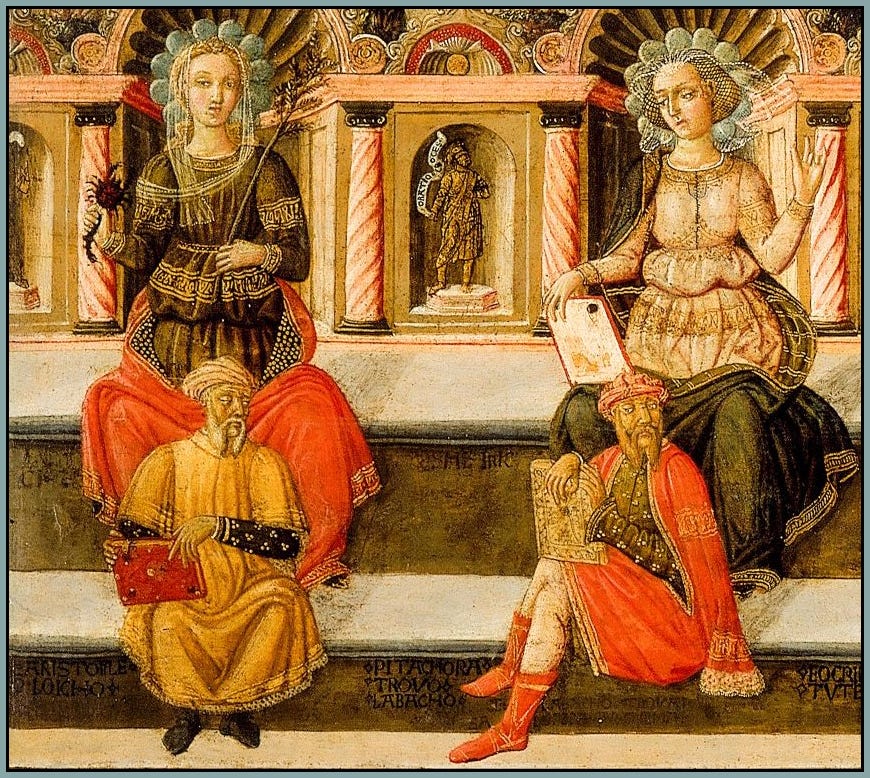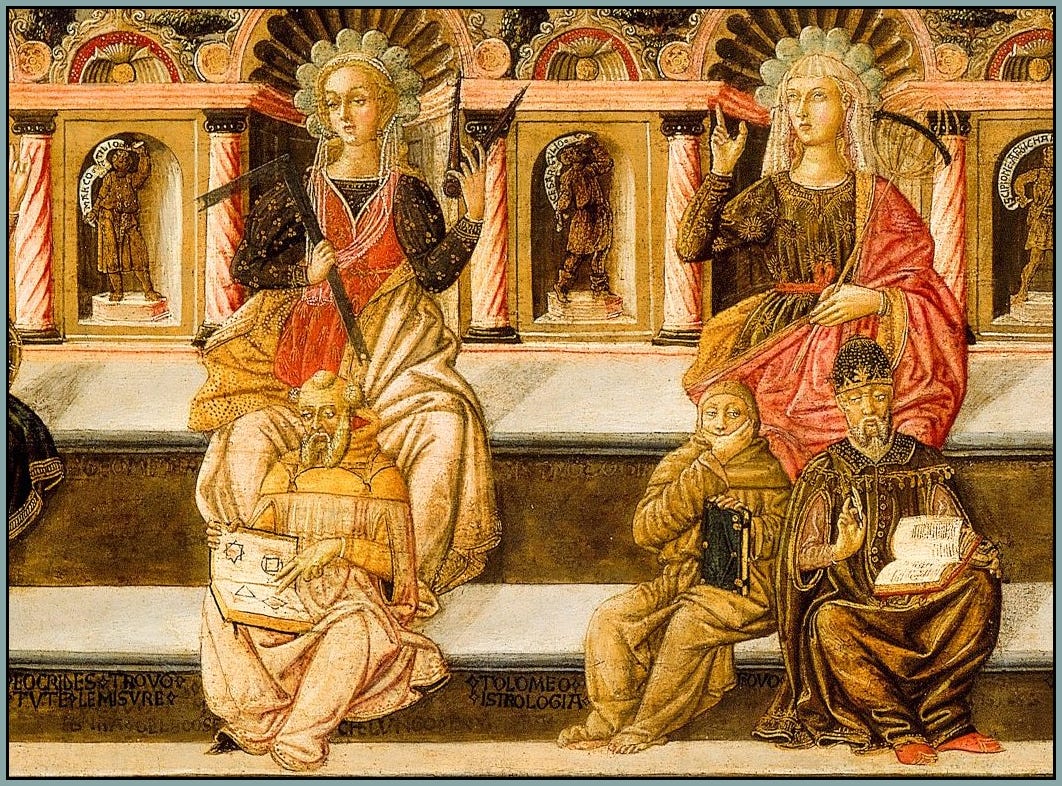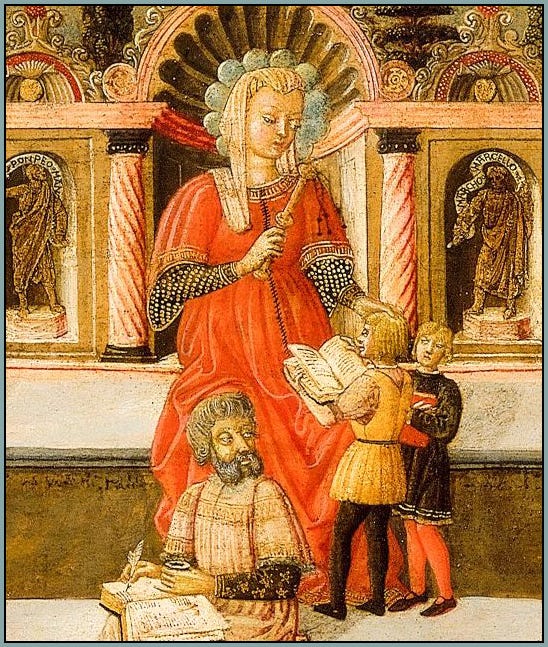Did Medieval Christians Understand Their Latin Liturgy?
The assumption seems to be that they did not.
soles occidere et redire possunt…
One of the graduate courses that I took was particularly strange. It was about the theory and practice of language acquisition, and as a dedicated language learner—by that point in my life I had already studied Latin, Romanian, Spanish, French, and Italian—I enrolled enthusiastically. I did a lot of reading and writing for that class, and added (at least temporarily) fancy new terms to my scholarly lexicon: interlanguage, universal grammar, processability theory, contrastive analysis hypothesis, creative construction hypothesis, affective filter hypothesis… Despite all that, what I did not do, and this is the strange part, is learn anything that significantly improved my real-life ability to learn or teach languages.
It wasn’t the fault of the English department, or of the textbook authors, or of the professor. The problem is simply that language acquisition is an exceedingly complex and fundamentally mysterious process. Indeed, what that class taught me above all is to respect the mystery of mankind’s ability to gain proficiency—for most people, extraordinary proficiency—in linguistic communication. It’s no small matter when a university-level, modern-science-based textbook must discuss something called “poverty of the stimulus,” meaning that “children come to know certain properties of grammar that are not obviously learnable from input.” Thus, it seems that human beings—under the right circumstances—know more about using a language than the material world has taught them. For someone like me, that’s not so surprising: God is the logos, which in Greek means something closer to “speech” than to “word,” and if this divine Speech dwells in your soul and permeates your mind, you have within you the fount and fulfillment of every earthly language.

The question that I asked in the title of this post is imprecise in multiple ways: Does “Christians” refer to clerics, scholars, aristocrats, townsfolk, rural laborers? Does “medieval” refer to the sixth century, or the eleventh, or the fifteenth? Does “understand” refer to conscious comprehension, or intuitive awareness, or acquisition of certain key phrases? Does “liturgy” refer to Sung Mass, Low Mass, the divine office…? There are too many variables here; no comprehensive solution is possible.
The question still needs to be asked, though: first, because it’s monumentally important; second, because even a partial answer is valuable; third, because the prevailing assumption, in my view, is not quite right.
It’s monumentally important because the sacred liturgy is humanity’s principal and most transformative encounter with supernatural realities. When it comes to transporting man’s body and mind from the world of ephemerality and death to the heaven of eternity and immortality, nothing else in the Christian life can do what numinous, poetic liturgical celebrations can do. There is no more potent reminder that earthly life is a preparation for something far better, and that the soul can never be satisfied with material goods, and that the very essence of practical wisdom is to “seek first the kingdom of God.” Indeed, the sacred liturgy is—not figuratively, literally—the kingdom of God, that is, an enclosed and consecrated domain, both physical and conceptual, where the laws and leaders of the temporal realm recede into the background while the ceremonies, precepts, aspirations, and sovereignties of heaven take center stage. Imagine Mass in the Middle Ages: Where is the feudal lord? Where is the duke? Where is the king himself? In a place of honor, to be sure, but among the congregation. Who conducts the service? Who offers the sacrifice? Who reads the “royal decrees” of Missal and Scripture? Who is elevated, visually and juridically, above the people? Christ the King, represented by His priest and present in His sacrament. Are you sick and tired of postmodernity’s nihilistic regime, with all its suffocating materialism and ugliness, its insipid “democracy,” its flaccid “synodality,” its oppressive STEMpire and technocratic hellscapes? Medieval liturgy—miraculously, something quite close to it still exists and is widely available—can be your refuge.
However: for those of who have inherited the culture of western Christendom, the language (supposedly “dead”) of medieval liturgy is Latin. I will be the first to say (indeed, I have said) that “the ‘Latin’ Mass speaks many languages, and not one of them is dead.” But at the same time, we ought not dismiss the great benefits of comprehending traditional liturgy in its verbal dimension. This is especially true when we consider the centrality of words in the divine office, nowadays largely forgotten despite the fact that if the liturgical heart of the Mystical Body is the Mass, the two sides of the choir singing the office are its lungs. Eloquent prayers, sacred poetry, captivating songs, luminous narratives: all these—born of the union between Christ and His Church, nurtured through centuries by His divine Spirit—are our liturgical birthright. They are joy, consolation, insight, contemplative transformation, and their power to edify and sanctify is a precious gift that need not be left unopened.
That’s why the question at hand—did medieval Christians understand their Latin liturgy?—is so crucial. The answer helps us to explain how the liturgy did or did not help the medieval Church, from village to cathedral to monastery and beyond, to flourish in so singular a fashion. And therefore it also helps us to imagine how the Church might flourish once again.
I reiterate that the question cannot be answered in any general or definitive way. It is undeniable that a large majority of medieval Christians did not receive extensive formal education in Latin. Indeed, a great many were illiterate even in their native language. It’s also very likely that comprehension steadily diminished during the course of the Middle Ages, eventually reaching a point that was low enough to displease (or infuriate) Protestant “reformers,” and spur them along in their quixotic journey toward vernacular liturgy.
However, allow me to play the role of the contrarian, and propose some reasons to believe that people from all corners of medieval society—not just knights, administrators, and other potentially educated folks but also plowmen, silversmiths, dairymaids, busy mothers, and so on—possessed a significant ability to comprehend liturgical Latin. I offer this mostly on a “for your consideration” basis, since a complete and rigorous discussion of the issues at hand would require a book rather than an article.
First, we must remember that, relatively speaking, Latin was widely understood in the Middle Ages. Proficiency in Latin was central to education in the medieval West, whereas nowadays, numerous scholars and clerics study it superficially or not at all. Modern perspectives manage to frame this as a complaint: “Only priests and monks spoke Latin, and therefore the liturgy became the private possession of clerics, with the laity excluded and disenchanted!” This is at best a misleading exaggeration, but even if it were true, there were a lot of priests and monks in the Middle Ages! If we combine them with educated laymen, maybe five or ten percent of the people in a given medieval community knew Latin quite well. That’s a nontrivial (and actually very high, by modern standards) proportion, and it includes those whose vocation most directly demands a deeply liturgical spirituality.
This follows from the previous point: In a society where Latin is the linchpin of the educational system, teachers are easier to come by. It seems possible that some monks, parish priests, or scholars provided informal instruction to help ordinary folks understand important parts of the Mass. Memorization of key phrases does not require complex grammatical study and could, if continued in the long term, lead to fairly high levels of comprehension—especially for those who benefit from linguistic affinity, which leads to the next point.
We might assume partial comprehension for anyone who grew up speaking a Romance language—and this was a large proportion of those who lived among the four historical Latin liturgical rites. Christians in modern-day Spain (the Mozarabic rite), France (the Gallican rite), and Italy (the Roman or Ambrosian rite) had native fluency in a language whose primary and not-so-distant ancestor was Latin. Nowadays, speaking Spanish, French, or even Italian doesn’t give you much ability to understand Latin, but we can’t project that experience onto the Middle Ages, especially the Early Middle Ages, when a gradual transition from Latin to Romance vernaculars was occurring. Folks in the British Isles, Scandinavia, and Germany were at a disadvantage here.
This last point is the most unconventional and perhaps the most important. It is basically a truism to say that immersion starting in infancy is the best way to learn a language, and what we might easily overlook is the extent to which medieval Christians were immersed, from infancy, in liturgical Latin. I’m certainly not claiming that frequent participation in liturgical or paraliturgical ceremonies would make someone conversationally fluent in the Latin language. But what is the cumulative effect of all those hours, starting almost from birth, in which liturgical Latin—the Mass, the sacraments, the divine office, blessings, processions, songs—is not only heard but reinforced and to some extent “translated” by ritual actions? The fact is, modern people cannot know what the cumulative effect might be, because the medieval world’s superabundance of liturgical Latin is long gone. There’s no way to test a hypothesis. But my instinct tells me that the resulting comprehension could have been significant, especially since the medieval mind was adept at acquiring knowledge in this poetic, rather than analytical, way.
I introduced this essay by reflecting on the mystery of language acquisition, and the sacred liturgy is, like the home of a loving family, an environment especially conducive to mysterious forms of learning. Who knows what sort of subconscious comprehension was achieved by unlettered peasants with zero knowledge of Latin grammar but vast exposure to the words and phrases by which the eternal God was invoked, His saints extolled, His truths proclaimed, and His goodness poured forth into the lives of men?
The epigraph to this essay means “suns are able to set and rise again.” It’s from a classical Latin poem known as Catullus 5. The poem is famous, but not (to put it mildly) particularly edifying. And yet, there’s something in that Latin line, soles occidere et redire possunt, that captures the enduring power of the Latin language. It is a sun that has illuminated Western culture—literature and rhetoric, law and governance, prayer and worship, philosophy and pedagogy—for over two thousand years, and though it doesn’t always glow as brightly as it should, and sometimes dips almost out of sight, it has a remarkable ability to rise again.
Medieval culture and the Latin language are inseparable, and therefore I’ve decided that the Via Mediaevalis newsletter must do its part to help keep the Latin sun above the horizon. You may not have noticed, but we recently completed The Medieval Year; the first Medieval Year post was in July of 2024, and we ended in June of 2025. I’m going to replace The Medieval Year with a series dedicated to Learning Liturgical Latin. The plan is that every week, paid subscribers will receive a third post intended to help any motivated learner do one specific and achievable thing: understand and enjoy the Latin prayers, readings, and chants that we hear at Sunday Mass. I believe that for most people—including myself, since I’m an English scholar, not a classicist—the best thing you can do with Latin is deepen your relationship with, and enrich your experience of, the sacred liturgy. Children who are studying Latin for school could also benefit, since this series will make textbook knowledge feel more meaningful, rewarding, and sanctifying by drawing it into the lived reality of God’s liturgical kingdom.
We’ll take a closer look at what “liturgical Latin” is, and discuss how it can be learned, in Tuesday’s post.











I do think Latin literacy and comprehension in the medieval period are underestimated. Every parish church would have a number of clerics in minor orders, along with priests and deacons, plus a bunch of boys learning the ropes in what were effectively schools. Not all of them would become priests, but in the meantime they would learn Latin and written English along with Gregorian chant and sometimes other subjects. So in any parish a significant number of parishioners were literate to some extent. The popularity of The Layfolks Mass Book in the 14th century, with its reference to parts of the Mass in Latin (assuming knowledge at least of the form/structure) speaks to good levels of literacy. My view is that the assumption of lack of understanding of Latin is a relic of Protestant propaganda rather than fact.
I remember when I first attended a Vietnamese Mass. Robert, the angelic sound of the voiced responses was enough to transport me to another place. I knew not what words they spoke, but I knew the sequence and timing and filled in the mental prayer in English.